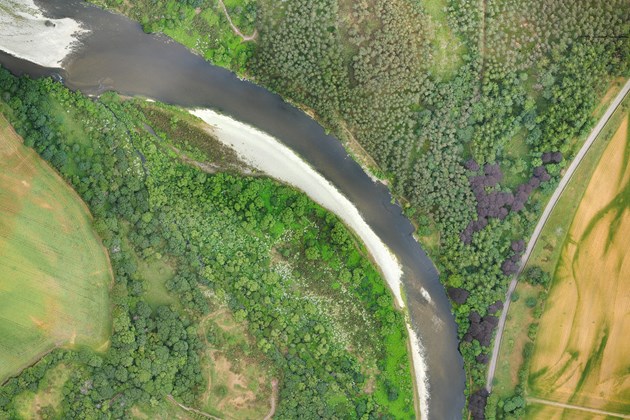27 August, 2018
Eye in the sky reveals hidden alien invaders

The Spey Fisheries Board and the Scottish Invasive Species Initiative have located hidden patches of the invasive non-native Giant hogweed and Japanese Knotweed plants, thanks to a high-tech drone flying over the River Spey.
The comprehensive aerial photography survey of the lower stretch of the River Spey from Fochabers to Spey Bay was funded by Crown Estate Scotland.
Brian Shaw, biologist with the Spey Fisheries Board explained: “We’ve been tackling invasive species along the River Spey for a number of years now, particularly working on Giant hogweed, and we have made excellent progress upstream of Fochabers. We are confident that the upper river is now clear of these pesky plants and we’ve gradually been working our way downstream. We are now turning our attention to the lower Spey - but the woodland alongside the river is really dense and finding the plants is extremely difficult, it’s like fighting through a jungle! By using aerial photography, we are able to ensure we aren’t missing anything.”
Despite the good results so far, Spey Project Officer for the Scottish Invasives Species Initiative, James Symonds, pointed out there’s still more work to do: “The survey was fantastic, but it did reveal some huge stands of Knotweed and Hogweed that we were previously unaware of so there will be a lot more hard work over the next few years until we can get these areas under control - but I’m up for the challenge!
“We’ve made some good progress in the Spey Bay estuary area already this year, working with staff and volunteers from both the Whale & Dolphin Society’s Spey Bay centre and the Scottish Wildlife Trust, who manage the Spey Bay reserve. We’ve all joined forces to tackle the Giant hogweed and will re-double our efforts next year in a concerted and concentrated attack on this problem plant. Of course, we’d welcome any new volunteers who want to join us to help.”
Working in partnership is key to the success of the Scottish Invasive Species Initiative. Project Manager Callum Sinclair explained: “Invasive species are a big threat to the nature of Scotland and so it’s crucial we address the problem, but we can’t do it on our own. We are actively working with partners to put in place sustainable, long-term control for the worst offending invasive species. The support of Crown Estate Scotland on the Spey has clearly helped make our control work there more effective and efficient – if a little more daunting.
“We’d welcome assistance from any organisations, communities or individuals who want to get involved and help us control these problematic invasive non-native species on the Spey or elsewhere in the north of Scotland. We have a range of volunteering opportunities available and you can get in touch by emailing us at sisi@nature.scot ”
Giant hogweed is just one of the invasive (alien) species that the Scottish Invasive Species Initiative will be tackling over the next 4 years. Not only do these plants out-compete native flowers and disrupt the ecosystem, they can cause serious burns on contact with the skin and so present a real hazard to humans. The initiative is also controlling American mink, Japanese knotweed and Himalayan balsam.
The Initiative is a 4-year partnership project, led by Scottish Natural Heritage, with funding from the Heritage Lottery Fund, and working with many fisheries trusts and boards. It is working throughout northern Scotland from the Tay catchment in the south to the remote catchments of North West Sutherland.
Notes to editors
For more information about the Scottish Invasive Species Initiative, visit: https://www.invasivespecies.scot/
NatureScot is Scotland's nature agency. We work to enhance our natural environment in Scotland and inspire everyone to care more about it. Our priority is a nature-rich future for Scotland and an effective response to the climate emergency. For more information, visit our website at www.nature.scot or follow us on X at https://x.com/NatureScot
’S e NatureScot buidheann nàdair na h-Alba. Bidh sinn a’ neartachadh àrainneachd na h-Alba agus a’ brosnachadh dhaoine gu barrachd suim a chur ann an nàdar. Tha e mar phrìomhachas againn gum bi nàdar na h-Alba beairteach agus gun dèilig sinn gu h-èifeachdach le èiginn na gnàth-shìde. Tha an tuilleadh fiosrachaidh aig www.nature.scot no air X aig https://x.com/NatureScot


